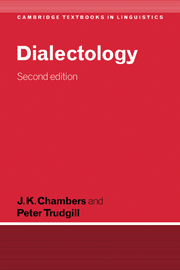Book contents
- Frontmatter
- Contents
- Maps
- Figures
- Tables
- Preface to the second edition
- The international phonetic alphabet
- BACKGROUND
- SOCIAL VARIATION
- SPATIAL VARIATION
- MECHANISMS OF VARIATION
- 9 Variability
- 10 Diffusion: sociolinguistic and lexical
- 11 Diffusion: geographical
- 12 Cohesion in dialectology
- References
- Index
11 - Diffusion: geographical
Published online by Cambridge University Press: 05 June 2012
- Frontmatter
- Contents
- Maps
- Figures
- Tables
- Preface to the second edition
- The international phonetic alphabet
- BACKGROUND
- SOCIAL VARIATION
- SPATIAL VARIATION
- MECHANISMS OF VARIATION
- 9 Variability
- 10 Diffusion: sociolinguistic and lexical
- 11 Diffusion: geographical
- 12 Cohesion in dialectology
- References
- Index
Summary
For many years, people studying geographic diffusion assumed that innovations spread continuously along immigration routes or transportation lines. This conception was often expressed by analogy to a wave. The ‘wave model’ visualised innovation diffusion as a pebble-in-a-pond effect, with a centre of influence (the point of impact of the pebble) sending ripples outwards in all directions (the movement of the wave).
A more accurate analogy in the light of studies made in the last fifty years would be skipping a stone across a pond. Innovations diffuse discontinuously from one centre of influence to other centres (the successive points where the stone hits) and from each of those into the intervening regions (in waves that sometimes overlap). In other words, innovations leap from one place, usually a city, to another place, another city or large town, and then move into the places between, such as towns and villages.
This view is largely due to the Swedish geographer Torsten Hägerstrand, who tracked the spread of several innovations across the landscape. Although Hägerstrand's evidence came from non-linguistic innovations such as the spread of the automobile and of controls against bovine tuberculosis, there was no reason to think that the regional diffusion of linguistic innovations would work differently.
Indeed, dialectologists who know Hägerstrand's work and that of his followers are very likely to think of analogous cases having to do with linguistic innovations.
- Type
- Chapter
- Information
- Dialectology , pp. 166 - 186Publisher: Cambridge University PressPrint publication year: 1998

